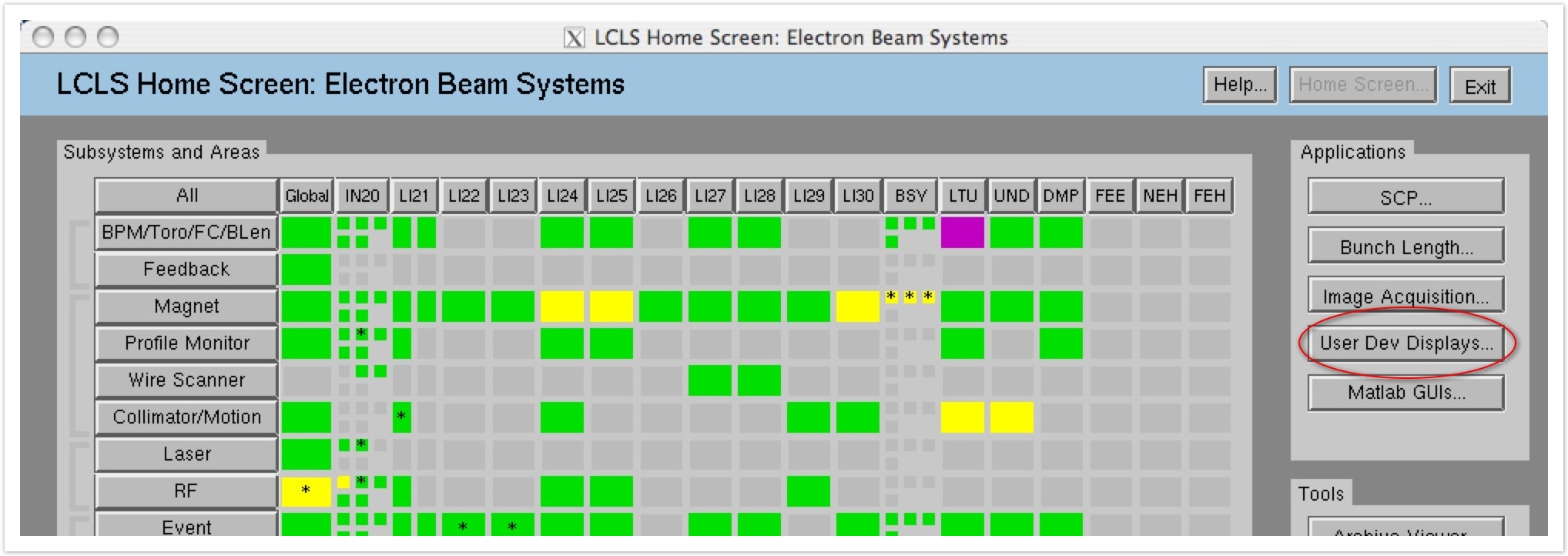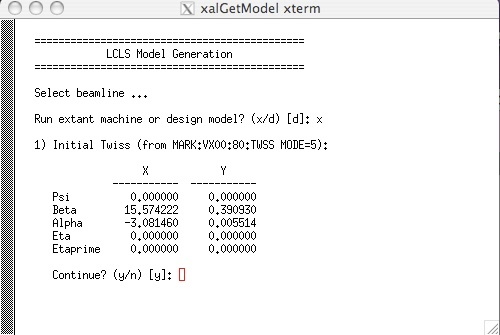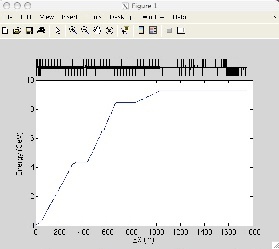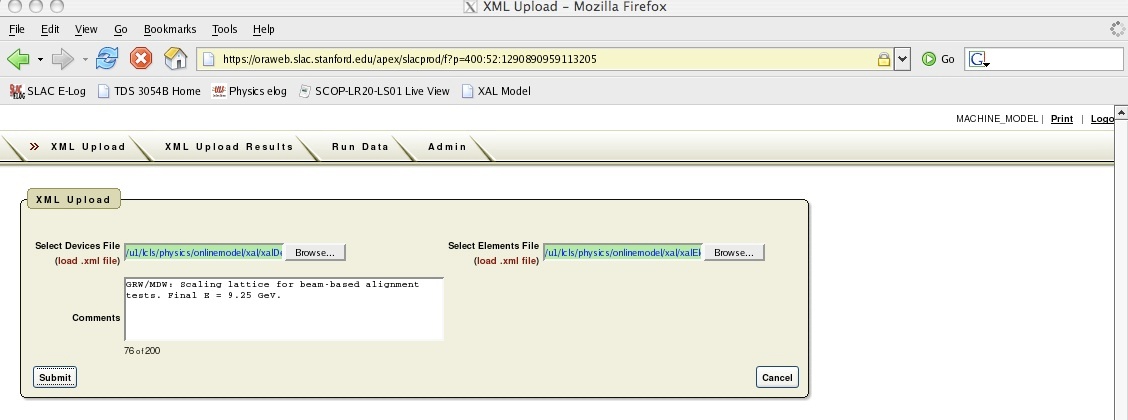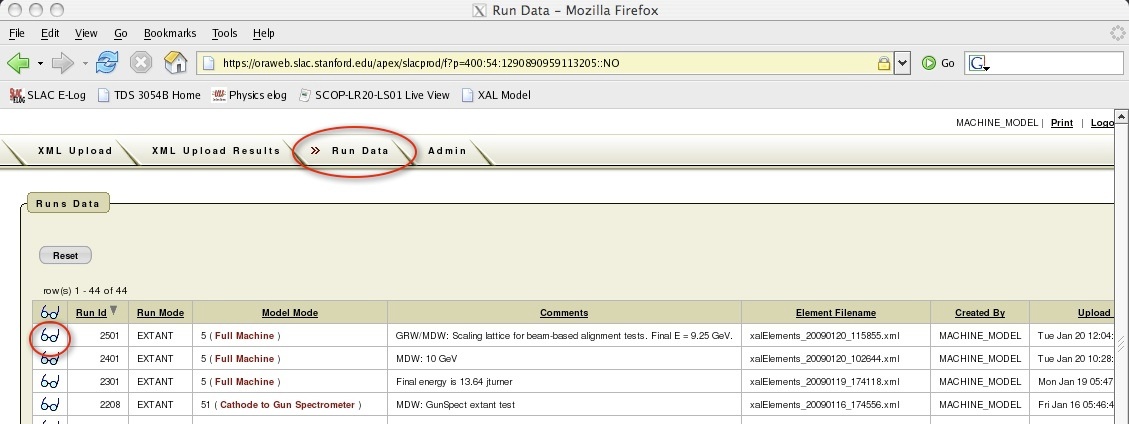...
From lclshome, select User Dev Displays panel.
Run one of the matlab scripts xalRunModel or xalGetModel
*xalRunModel* simply runs the model and creates the upload files
*xalGetModel* is as xalRunModel, but additionally returns ("gets") the model data to your matlab session. It also creates model plots.
Either of these buttons will start the corresponding matlab script...
... which immediately prompt for you to *Select a beamline* :
\\
The following is a run-through of running xalGetModel for the Extant machine. [Click here to see the full transcript of this example ].
The procedure is as follows:- For example, select "Cathode to Dump" (as shown in the example above). This runs the LCLS "Full Machine" model, from the LCLS Cathode to the main Dump. See Why are all models from Cathode to some location.
Wiki Markup *Select
whether
to
"Run
extant
machine
or
design
model?
(x/d)
\[d\]:*".
Hit
x
or
d,
and
RETURN.
Running the
Running the "design"model
(choice
"d")
causes
the
XAL
model
to
be
run
with
the
element
setpoint
values
in
the
model
input
files.
Those
design
setpoint
values
are,
[to
the
extent
possible,
identical
to
the
MAD
design|#modeldiffs].
Running
the
"extant"
model
(choice
"x")
will
cause
the
model
execution
to
first
replace
the
design
values
of
beamline
devices,
with
the
actual
readback
values,
as
acquired
through
EPICS
and
AIDA,
prior
to
running
the
envelope
tracker.
ThatThat is,
"extant"
is
equivalent
to
what
was
called
"DATABASE"
in
the
SLC
modelling
system;
it
describes
the
extant
machine
at
the
time
the
model
is
run.
!image:xalGetModelextant.jpg|thumbnail!*Stages
of
running
the
(extant)
model
are
as
follows:*
Wiki Markup *1)
"Initial
Twiss"*
is
displayed.
Check
the
initial
conditions
which
will
be
used
for
the
model
run.
These
are
presently
taken
from
the
SLC
marker
point
80.
You
can
check
these
at
any
time
with
AIDAWeb
([MARK:VX80:80//twiss
the
values
are
Energy
(GeV),
psix,
betax
(m),
alphax
,
etax
(m),
etax',
psiy,
betay
(m),
alphay,
etay
(m),
etay')
Ifthese
appear
fine,
then
confirm
to
continue.
!image:extantinitconditions.jpg|thumbnail!*2) "Run LEM
Wiki Markup 'Lite'"*.
This
will
calculate
and
display
the
fudge
factors
and
predicted
energy.
When
it
has
completed,
_check
in
particular
that
the
final
energy
at
the
undulator_
(see
Energy
column,
and
the
row
of
output
labelled
"BSY")
is
reasonable,
e.g.
9.25
GeV.
If
energy
appears
fine,
then
confirm
to
continue.
!image:checkenergies.jpg|thumbnail! unmigrated-wiki-markup*3)
"Run
XAL
machine
model."*
This
can
take
up
to
a
minute
to
execute,
so
please
be
patient.
When
it
has
completed,
if
you
ran
xalGetModel,
you
should
get
3
plots
-
the
dispersion,
betas,
and
energy
vs
Z.
The
plots
may
overlap,
and
the
energy
plot
is
on
the
bottom,
so
move
the
others
to
check
it.
!image:energyGraph.jpg|thumbnail!- 4) "Create MAD patch file". This stage is always entered, you don't need to do anything. It only takes a moment to create these.
Wiki Markup "Create
and
upload
XML
model
files
to
Oracle?
(y/n)
\[n\]:
"
If
it
all
looks
good,
and
you
want
to
upload
to
Oracle,
say
"y".
!image:oracleuploadprompt.jpg|thumbnail!5) "Run XML writer." If you said "y" to create the upload files, you'll now see "Run XML writer." This is where the file containing the model results to be uploaded to Oracle, is created. This also takes half a minute or so.
When it has completed, you should see that 3 files have been created: E.g.Code Block /u1/lcls/physics/onlinemodel/xal/xalElements_20090120_115855.xml created /u1/lcls/physics/onlinemodel/xal/xalDevices_20090120_115855.xml created /u1/lcls/physics/onlinemodel/xal/xalModel_20090120_115855.mat created
- Upload the XAL model online on the web.
The last part of xalGetModel gives some tips of uploading. It remins you where to find the model files in the browser, and the URL of this help. See next the section of help with uploading the model files.
...
- Select Device File
Hit the "Select Device File" button. You can either enter a full filename by hand, or use the filebrowser, to browse to /mccfs2/u1/lcls/physics/onlinemodel/xal/ and select the Devices file you created in the process above. in our example above this files was named "xalDevices_20090120_115855.xml". (Tip: since there are many files in this directory, hit "Last Modified" twice, to sort the files by date, latest first). Select the xalDevices file you created, and hit the Open icon (with a picture of a folder!) in the filebrowser dialog to make the selection. (It's a bit confusing using the word "Open" to mean "Select" - talk to Oracle about that - they went cheap and used the firefox file selection widget, designed for selecting a file to open, but they use it to mean "select"). - Select Elements File
Hit the "Select Elements File" button. The filebrowser should open at the right directory - amazing! Hit "Last Modified" twice to sort the files again, and click on the xalElements file you created in step 2.2.5 above. Hit "Open".
(You do not need to upload the xalElements file at all). - Comments.
Enter a comment. Please include 2 items in your comment:- Your name, nickname, mark, catchphrase, or other distinguishing refrain from which your personal guilt can be established.
- The Energy at the undulator predicted in step 2.2.3 above!
*Submit*.
Whenyou
are
finished,
the
screen
should
look
something
like
this:
!image:comment.jpg|thumbnail! Hit theHit the "Submit"
button.
The
time
to
upload
is
about
1
minute!
Note
that
additional
time
is
presently
spent
creating
the
screen
which
echos
the
upload
data,
but
in
fact
the
model
data
is
available
for
use
as
soon
as
you
see
the
XML
Upload
Results
table:
!image:XMLUploadResults.jpg|thumbnail!
Review the model data.
...
Hit
...
the
...
"Run
...
Data"
...
tab
...
to
...
review
...
the
...
uploaded
...
results
...
of
...
any
...
model
...
which
...
has
...
been
...
uploaded,
...
including
...
the
...
last.
...
Hit
...
the
...
little
...
spectacles
...
icon
...
next
...
to
...
a
...
model
...
upload
...
to
...
view
...
the
...
model
...
parameters
...
of
...
each
...
element
...
calculated
...
as
...
part
...
of
...
that
...
model.
...
This interface takes a while to load the data, but it can do it for any uploaded model.
Alternatively, use AIDA to check the Rmats of the model elements for the latest upload.
...
